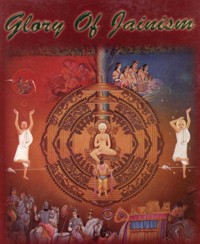Shri Bhadrabahuswami
Shrutkevali (knower of all the canonical literature) Shri Bhadrabahuswami was the seventh in the line of pattadhars (chief disciple) of Lord Mahavir. Reputed Acharya Yashobhadra’s disciple as he was, he had the knowledge of 14 purvas (early canons). At the age of 45 years he accepted the life of penance and restraint, in the presence of Acharya Sambhut Vijayji he was designated as acharya (head of a mendicant group). For over 14 years he ably managed the affairs of Jinshasan (Jain order) and added honour and glory to the post. He died at the age of 76 years and with him the tradition of Shrutkevali came to an end.
Shri Bhadrabahuswami was born in Pratishthanpur. He and his brother Varahmihir both were expert scholars of 4 vedas and 14 vidyas. Their meeting with Shrutkevali Shri Yashobhadrashri resulted in their initiation. However, the Guru considered Bhadrabahu as a more deserving candidate for the learning of 14 purvas as also the acharyapad and so the Guru appointed him as his successor. This decision irritated and enraged Varahmihir who ultimately renounced his initiation. About this time, a child was born to the king and Varahmihir made a forecast that the boy would live for one hundred years.
Incidentally, sanghnayak (leader of a congregation) Bhadrabahuswami staying in the same city did not go to the palace to bless the child and to congratulate the king. Seizing this opportunity Varahmihir instigated the king and the people against Bhadrabahuswami. When Bhadrabahuswami came to know all this, he said that he knew that on the seventh day the boy was to die because of a cat and so he had decided to call on the king to console him. Though he had full faith in the forecast of Varahmihir, the king took all precautions and arranged to catch and drive away all the cats out of the town in the forest area.
The child was kept under strict surveillance. But as destined, the wooden bar at the door with a cat’s figure on it fell on the child’s head, killing him instantly. On this shocking and sorrowful occasion, Bhadrabahuswami went to the king to convey his consolation. Greatly moved by this gesture, the king offered him unusual honour. Varahmihir had failed in his plan and steeped in his own anger and enmity, Varahmihir was born as ‘Vyanterdev’ (a class of lower god) in his next birth and by means of knowledge he came to recall his earlier birth and soon became jealous of the Jain sangh.
He then managed for the spread of plague amongst the Shreesangh as a result of which a number of people began to die suddenly and instantly. Shreesangh requested Bhadrabahuswami to do something and by the sheer force of his shrutgyan (scriptural knowledge) he could correctly assess the entire situation and with a view to getting rid of the nuisance he composed Uvasaggahar Stotra. The impact of this great stotra (devotional song) was so great that the strength of Vyanter got immensely diminished. Acharya Shri Bhadrabahuswami also composed ‘Paryushan Kalpasutra’ which is popularly known as ‘Kalpasutra’. It is also believed that he wrote Niryukti on ten sutras.
He composed four Chhed sutras (a law book dealing with monastic offences) and wrote monumental works like ‘Bhadrabahu Samhita’ and ‘Vasudevcharit’ containing one lakh and twenty five thousand pads (verses). Thereby he imparted invaluable knowledge of the purvas (early canons) to Arya Sthulbhadra, and thus he managed to preserve the great heritage from perishing. He attained the unique achievement of intense meditation of Mahapran dhyan constantly for twelve years. Bhadrabahuswami is respected as the fifth and final shrutkevali in both the shwetambar and digambar traditions.
 Dr. Kumarpal Desai
Dr. Kumarpal Desai

